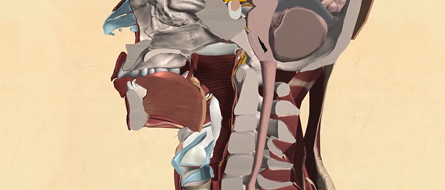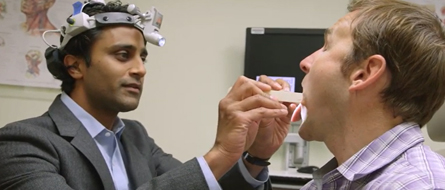Overview
About Nasopharyngeal Cancer
What is nasopharyngeal cancer?
Nasopharyngeal cancer usually starts in the nasopharynx, the small chamber above the soft part of the roof of the mouth and behind the nasal passages. This type of cancer is rare, particularly in the United States. If the cancer is confined to the nasopharynx or neck lymph nodes, treatment can usually cure it.
How does nasopharyngeal cancer develop?
Nasopharyngeal cancer develops when cells inside the nasopharynx mutate (change abnormally) and grow out of control. People of Asian and Pacific Islander descent and those exposed to the Epstein-Barr virus are more likely to develop nasopharyngeal cancer.
Connect to Care
Let us help find personalized care options for you and your family.
Symptoms of Nasopharyngeal Cancer
The nasopharynx is close to the eyes, ears, and nose. Symptoms of nasopharyngeal cancer usually occur in those areas and include:
- Changes in hearing or vision
- Headaches
- Lump in the nose or neck
- Nasal congestion or bleeding
- Sore throat
- Swelling of lymph nodes in the neck, especially those below the ear
- Trouble breathing or speaking
Nasopharyngeal Cancer Risk Factors
In most cases, we don’t know what causes nasopharyngeal cancer. However, some factors may increase your risk, including:
- People of Asian and Pacific Islander ethnicity, living in parts of Asia, particularly people who have lived in China long-term.
- Exposure to the Epstein-Barr virus
- Family history
- Smoking and heavy alcohol use
Types of Nasopharyngeal Cancer
Different types of cancerous tumors can develop in the nasopharynx. Types of nasopharyngeal cancer include:
- Nasopharyngeal carcinoma (NPC): This type of cancer starts in the cells that line the nasopharynx. Most cases of nasopharyngeal cancer are NPC.
- Lymphoma: This cancer of the immune system cells (lymphocytes) can start in the nasopharynx.
- Sinonasal adenocarcinoma and adenoid cystic carcinoma: These types of cancer can start in the minor salivary glands in the nasopharynx.
Benign (noncancerous) tumors can also develop in the nasopharynx. They may require minimal or no treatment.
Nasopharyngeal Cancer Stages
Staging is the process of determining whether cancer has spread and, if so, how far. Stage 0 describes the early signs of disease and Stage 4 indicates an advanced case.
Learning what stage your cancer is in helps you and your doctor make decisions about your treatment plan. This information also helps your doctor determine your prognosis (probable outcome based on the experience of others).
Stage 0: Abnormal cells are in the lining of the nasopharynx. They may turn into cancer and spread into nearby tissue. This stage is also called carcinoma in situ, which means “in its original place.”
Stage 1: A cancerous tumor is in the nasopharynx and may have grown into the oropharynx (the part of the throat behind the mouth), nasal cavity, or both.
Stage 2: Cancer is in the nasopharynx and may have spread to the oropharynx, nasal cavity, and lymph nodes on one side of the neck or behind the throat. Sometimes, there is no tumor in the nasopharynx but cancer cells in the neck’s lymph nodes are infected with the Epstein-Barr virus, which is likely to be NPC.
Stage 3: In addition to the conditions in stage 2, the tumor may be larger and may have spread to lymph nodes on both sides of the neck or behind the throat. Or, the cancer may have grown into nearby bones or sinuses and may or may not be present in lymph nodes.
Stage 4: This stage is divided into several substages, each describing how the cancer has spread to nearby or distant parts of the body.
Recurrent nasopharyngeal cancer
Recurrent nasopharyngeal cancer is cancer that has come back after being treated. The cancer may return in the nasopharynx or in other parts of the body.
Diagnostic Tests for Nasopharyngeal Cancer
We conduct a thorough evaluation to diagnose nasopharyngeal cancer. Your doctor asks about your medical history, completes a physical exam, and may recommend specific tests, including:
Your doctor first examines your head and neck, particularly your nose, mouth, throat, face muscles and lymph nodes in the neck. If they detect swollen lymph nodes, the doctor will perform a nasopharyngoscopy. This exam allows your doctor to check your nasopharynx and other parts of the throat. Nasopharyngoscopy types include:
- Indirect nasopharyngoscopy: Your doctor holds a mirror at the back of the throat and shines a light on it to see the nasopharynx’s reflection in the mirror.
- Rigid and flexible fiberoptic nasopharyngoscopy: Your doctor guides a nasopharyngoscope (thin tube with a lens or camera on the end) through your nose and into the nasopharynx. When evaluating you to determine a diagnosis, your doctor likely uses a flexible nasopharyngoscope and may take a tissue sample to check for cancer cells (biopsy). Doctors most often use rigid nasopharyngoscopes during surgery.
If imaging tests suggest you have nasopharyngeal cancer, your doctor may order a biopsy of the tumor. A biopsy takes a tiny sample of cells from abnormal areas to check for cancer.
Our doctors use several types of biopsies, including:
- Needle biopsy: Your doctor inserts a very thin needle (fine needle aspiration) or a wider needle (core biopsy) into a tumor.
- Endoscopy: Your doctor inserts an endoscope (a thin, flexible fiber optic tube with specialized tools) in the nose or throat to see and collect a sample.
Detailed images from the inside of your head and neck can help doctors determine your tumor’s size and location. Doctors can also use these specialized pictures to see if cancer has spread to lymph nodes or other areas. You may have one or more imaging tests, including:
- Chest X-ray: A technician aims an energy beam at your chest. A plate behind you captures images as the energy beam changes while passing through your skin, bone, muscle and other tissue.
- Computed tomography scan (CT scan): A specialized X-ray beam moves around your body while capturing pictures of bones, muscles, tissues, and organs.
- Magnetic resonance imaging scan (MRI): A large magnet, radio waves, and a computer work together to take clear, detailed pictures.
- Positron emission tomography (PET scan): This type of imaging measures your body’s cell activity. You receive a small amount of a tracer (a radioactive substance) that travels through your body. The tracer collects in areas of increased cell activity (typically indicating cancer) and appear brighter on the scan.
- PET/CT scan: PET and CT technology combine to show areas of increased cell activity and highly detailed images of nearby organs and tissues.
- PET/MRI scan: This PET and MRI combination shows cell differences and detailed images of the brain, internal organs and soft tissues. It uses less radiation than a CT scan.
Before and during treatment, we take small samples of your blood to test in the lab. Blood tests provide information about your health and help us monitor any potential side effects of nasopharyngeal cancer treatment.
One of your blood tests may check for Epstein-Barr virus (EBV), a condition that’s closely linked to nasopharyngeal cancer. Measuring the blood level of EBV DNA can help indicate a treatment’s effectiveness.
Nasopharyngeal Cancer
Nasopharyngeal cancer is a type of nose and throat cancer. Our nasopharynx cancer program is one of the largest in North America, with excellent outcomes.
Nasopharyngeal Cancer
throat cancer
head and neck cancer
nasopharynx cancer
nasopharyngeal carcinoma
nasopharyngeal cancer symptoms






